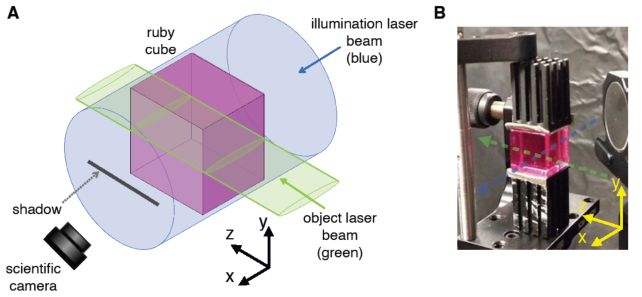Shadows are a pure consequence of opaque partitions in an illuminated Universe.
Mild shines; photons journey till they hit an object by means of which they can’t move; this blockage creates a shadow, somewhat piece of darkness the place the sunshine has been impeded.
Physicists, nevertheless, have simply found one thing very peculiar. A laser passing by means of the correct clear materials can power its environment to show opaque, virtually as if it casts its personal shadow.
When two beams of laser mild are crossed in simply the correct manner, the first beam is unable to move by means of the secondary – making a shadowed line within the mild that hits the alternative floor.
“Our demonstration of a really counter-intuitive optical impact invitations us to rethink our notion of shadow,” says physicist Raphael Abrahão of Brookhaven Nationwide Laboratory within the US.
Besides below very explicit circumstances, photons do not work together with each other, with intersecting waves passing proper by means of unimpeded.
When you cross two beams, they’re going to move by means of one another as if nothing is there – like shining one flashlight beam by means of one other.
Abrahão and his colleagues thought to analyze whether or not a beam of sunshine can solid a shadow virtually as a facet mission. They’d been finding out how beams of sunshine work together when nonlinear supplies are launched. These are supplies whose interactions with mild don’t scale in a linear vogue, leading to results corresponding to amplification, absorption, self-focusing, and harmonics (or frequency replication).
They had been utilizing 3D modeling software program to generate easy schematics for his or her experiments. On this software program, the beam of sunshine was represented as a stable cylinder that solid a shadow, and the physicists discovered that fairly humorous… till they discovered it fascinating.
“What began as a humorous dialogue over lunch led to a dialog on the physics of lasers and the nonlinear optical response of supplies,” Abrahão says. “From there, we determined to conduct an experiment to reveal the shadow of a laser beam.”
Ruby is a well-liked materials for finding out non-linear optics, so the researchers used one because the assembly level for his or her two lasers, one blue and one inexperienced.
The blue laser mild was directed at one facet of the ruby, the place it handed by means of and solid a cool glow upon a display, whereas a slender beam of inexperienced laser mild handed perpendicular to the primary from one other.

Wherever the skinny line of inexperienced mild fell on the ruby’s molecules, a posh dance of electrons rising and falling occurred. As a consequence, the marginally shorter wavelength of blue mild was befuddled by the transitioning electrons, its path by means of the in any other case translucent materials blocked.
The inexperienced laser beam subsequently behaves like an object, making a darkish line within the blue mild that lands on a display on the opposite facet of the ruby.
This darkish line met all the factors to be categorized as a shadow. It was seen to the bare eye; conformed to the contours of the display it was solid on; and moved with the inexperienced laser beam when the laser supply was moved.
“This discovery expands our understanding of light-matter interactions and opens up new prospects for using mild in methods we hadn’t thought-about earlier than,” Abrahão says.
“Our understanding of shadows has developed hand-in-hand with our understanding of sunshine and optics. This new discovering might show helpful in varied functions corresponding to optical switching, units during which mild controls the presence of one other mild, or applied sciences that require exact management of sunshine transmission, like high-power lasers.”
The analysis has been accepted for publication in Optica, and will be discovered on the pre-publish web site arXiv.





